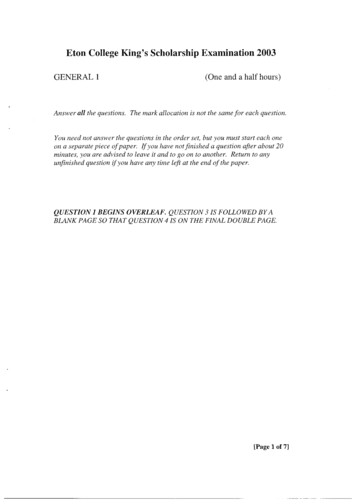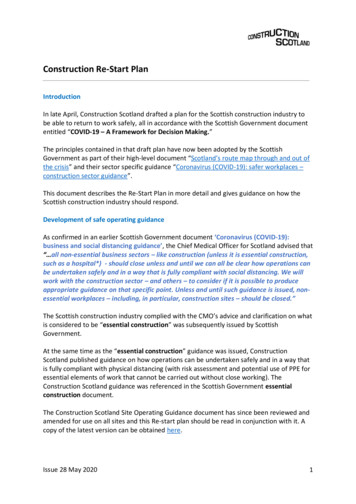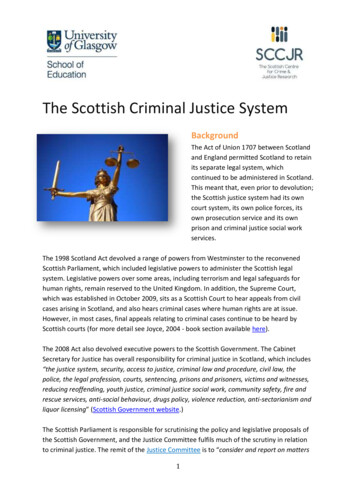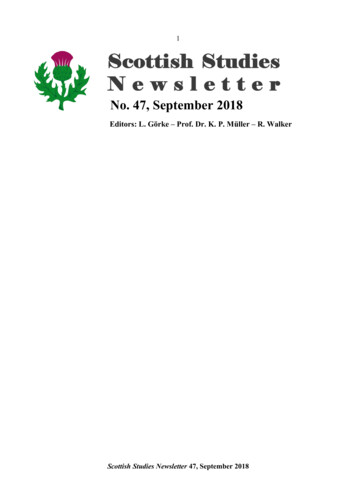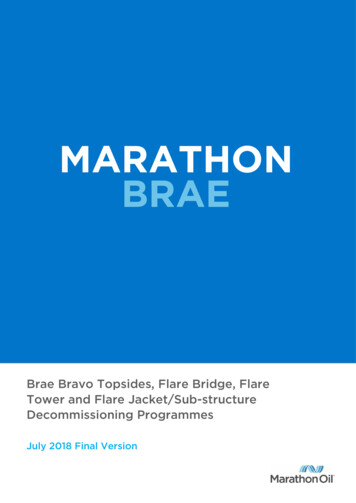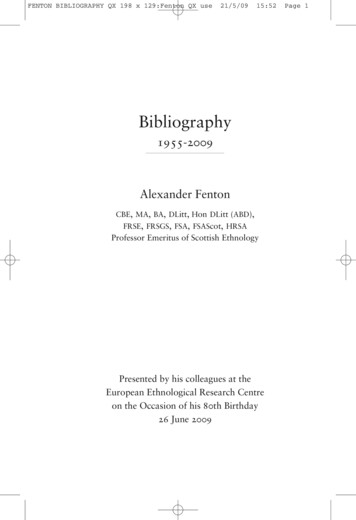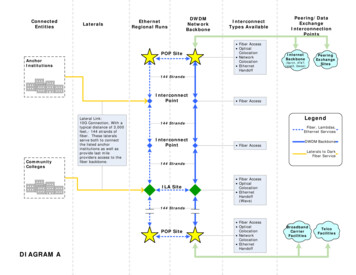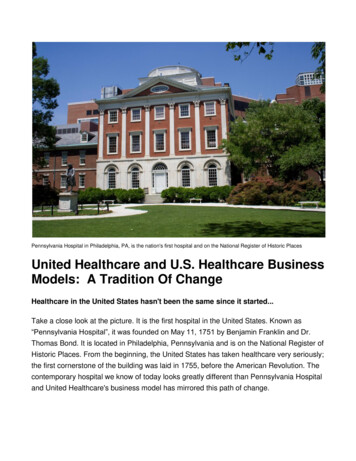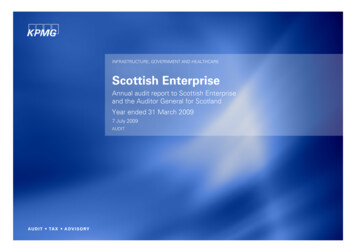
Transcription
INFRASTRUCTURE, GOVERNMENT AND HEALTHCAREScottish EnterpriseAnnual audit report to Scottish Enterpriseand the Auditor General for ScotlandYear ended 31 March 20097 July 2009AUDIT
ContentsThe contacts at KPMG inconnection with this reportare:David WattDirectorTel: 0141 300 5695Fax: 0141 204 1584david.watt@kpmg.co.ukAlly TaylorSenior ManagerTel: 0131 527 6813Fax: 0131 527 6666ally.taylor@kpmg.co.ukLaura WisemanAssistant ManagerTel: 0141 309 2552Fax: 0141 204 1584laura.wiseman@kpmg.co.uk Executive summary Introduction Accounts Use of resources Governance and accountability Performance Action planAbout this reportThis report has been prepared in accordance with the responsibilities set out within the Audit Scotland’s Code of Audit Practice (“the Code”).This report is for the benefit of only Scottish Enterprise and is made available to Audit Scotland (together “the beneficiaries”), and has been released to the beneficiarieson the basis that wider disclosure is permitted for information purposes, but that we have not taken account of the wider requirements or circumstances of anyone otherthan the beneficiaries.Nothing in this report constitutes an opinion on a valuation or legal advice.We have not verified the reliability or accuracy of any information obtained in the course of our work, other than in the limited circumstances set out in the scope andobjectives section of this report.This report is not suitable to be relied on by any party wishing to acquire rights against KPMG LLP (other than the beneficiaries) for any purpose or in any context. Anyparty other than the beneficiaries that obtains access to this report or a copy and chooses to rely on this report (or any part of it) does so at its own risk. To the fullestextent permitted by law, KPMG LLP does not assume any responsibility and will not accept any liability in respect of this report to any party other than the beneficiaries. 2009 KPMG LLP, a UK limited liability partnership, is a subsidiary of KPMG Europe LLP and a member firm of the KPMG network of independent member firms affiliated with KPMG International, a Swisscooperative. All rights reserved. KPMG and the KPMG logo are registered trademarks of KPMG International, a Swiss cooperative.1
Executive summaryExecutive summaryFollowing completion of a programme of significant organisational change in early 2008-09, management has focussed on changing internalplanning and reporting processes to ensure that these meet the needs of the organisation. The 2008-11 business plan is aligned to a newset of priorities: enterprise, innovation and investment. Projects, monthly reporting and the accounts have been similarly re-aligned.Scottish Enterprise’s review of ITI Scotland resulted in integration of Scottish Enterprise’s activities with ITI Scotland and a transition plan isnow in place.In line with best practice in the public and private sector, management commenced a two-phased introduction of zero-based budgetingduring 2008-09. This approach increases challenge at senior management level and aims to realise efficiencies for reinvestment.Scottish Enterprise met its financial targets – cash target, non-cash target and capital allocation – for 2008-09. Investment in property was 15 million and contributions to companies through financial investment was over 33 million. The 2009-10 financial plan forecasts thatScottish Enterprise will spend 319 million and aims to maximise impact on increasing Scotland’s sustainable economic growth.Robust procurement arrangements are now an important element in Scottish Enterprise’s responsibilities and all contracts greater than 50,000 are subject to tender.Management achieved efficiency savings of 8 million, primarily as a result of the restructuring programme, compared to the target of 7.7million. Scottish Enterprise will continue to be subject to achieving recurring efficiency savings of 2% in future years. 1 million of savingswill be achieved in 2009-10 and future years following the buy out of the employee car scheme in 2008-09.Management continues to assess progress against the Best Value action plan, but chose not to participate in Audit Scotland’s voluntaryprogramme of studies on efficiencies and information management during the year. 2009 KPMG LLP, a UK limited liability partnership, is a subsidiary of KPMG Europe LLP and a member firm of the KPMG network of independent member firms affiliated with KPMG International, a Swisscooperative. All rights reserved. KPMG and the KPMG logo are registered trademarks of KPMG International, a Swiss cooperative.2
IntroductionScopeOur audit work isundertaken in accordancewith Audit Scotland’sCode of Audit Practice(“the Code). ThisAudit frameworkThis year was the third of our five-year appointment by the Auditor General for Scotland as external auditors of Scottish Enterprise. Thisreport to Scottish Enterprise and the Auditor General provides our opinion and conclusions and highlights significant issues arising from ourwork.We outlined the framework under which we operate, under appointment by Audit Scotland, in the audit plan overview discussed with theaudit committee on 17 December 2008.specifies a number ofThe purpose of this report is to report our findings as they relate to:objectives for our audit. the accounts and our audit opinions on net operating costs and the regularity of transactions; use of resources, including financial outturn for the year ended 31 March 2009 and financial plans for 2009-10 and beyond; arrangements around governance and accountability, including risk management, systems of internal control, partnership workingand our consideration of the work of internal audit; and performance management and Scottish Enterprise’s arrangements to achieve efficiency savings.Best ValueAudit Scotland and the Scottish Government have been committed to extending the Best Value audit regime across the whole public sectorfor some time now, with significant amounts of development work having taken place during the last year. Using the Scottish Executive’snine Best Value principles as the basis for audit activity, Audit Scotland selected five areas as priority development areas (use of resources,governance and risk management, accountability, review and option appraisal, and joint working). Audit Scotland is developing a series oftoolkits that auditors are using from 2008-09. Management declined to participate in reviews of information management and efficienciesduring 2008-09, primarily due to the timescales involved.Responsibilities of Scottish Enterprise and its auditorsExternal auditors do not act as a substitute for Scottish Enterprise’s own responsibilities for putting in place proper arrangements toaccount for the stewardship of resources made available to it and its financial performance in the use of those resources, to ensure theproper conduct of its affairs, including compliance with relevant guidance, the legality of activities and transactions, and for monitoring theeffectiveness of those arrangements and, through the accountable officer, to make arrangements to secure Best Value.Action planThis report includes an action plan containing areas for development or improvement identified during our accounts audit fieldwork. Wehave not repeated recommendations raised in reports issued during our earlier work in respect of our 2008-09 audit. Responsibility fortaking action and monitoring progress in response to all our recommendations lies with management.AcknowledgementWe wish to record our appreciation of the continued co-operation and assistance extended to us by your staff during the course of ourwork. 2009 KPMG LLP, a UK limited liability partnership, is a subsidiary of KPMG Europe LLP and a member firm of the KPMG network of independent member firms affiliated with KPMG International, a Swisscooperative. All rights reserved. KPMG and the KPMG logo are registered trademarks of KPMG International, a Swiss cooperative.3
IntroductionBackground – overview of activitiesOverview of activitiesDuring the year ended 31 March 2008 Scottish Enterprise implemented a programme of significant organisational change. Some regionalactivities, including Business Gateway, were transferred to local authorities and skills, learning and Careers Scotland activities weretransferred to Skills Development Scotland on 1 April 2008, along with 1,328 staff. The 12 local enterprise companies were abolished inoperational terms and subsumed within a central structure, with five newly created regions in operation during 2008-09. The changes tothe corporate structure also included a voluntary severance scheme in which 257 members of staff left the organisation.During 2008-09 management focussed on changing internal planning and reporting processes to ensure that these met the needs of theorganisation in its revised state. Scottish Enterprise realigned its business plan from the Metropolitan Scotland approach to align with theGovernment economic strategy. Management produced a business plan for 2008-11 aligned to a new set of priorities: enterprise,innovation and investment. Projects have been re-aligned under these three themes and their associated sub-themes. The accounts for2008-09 present the organisation’s expenditure under these new categories. The business plan for 2009-12 is also structured around thesethree key areas.As a result of extensive changes in the organisational structure, the executive board approved adoption of a zero-based budgeting approachto the development of the 2009-11 business plan. Implementation of this approach is on a phased basis. Phase one was completed in theautumn of 2008 and required submission of draft budgets to a challenge panel established by senior management. The second phase,during 2009, will focus on delivery models and the introduction of a consistent framework for consideration and approval of appropriatemodels. Management reports that good progress was made during 2008-09. Identification of drivers for decision-making had beenconsidered in the past, but the reasons for each driver are now considered to be clearer. Further work is required to develop a prioritisationframework and this will be progressed during 2009. Application of a zero-based budgeting approach is consistent with best practice acrossthe public and private sectors.ITI Scotland, a subsidiary of Scottish Enterprise, was established in 2003. Scottish Enterprise completed a review of ITI Scotland during2008-09. The review considered, among other areas, ITI Scotland’s strategic and operational objectives, cost effectiveness and efficienciesand the impact of the monitoring and evaluation framework on capturing the benefits of intellectual property commercialisation.Consideration of the findings of this review resulted in a view that greater integration of Scottish Enterprise’s activities with ITI Scotlandwas the preferred solution for future activity. An integration project was presented to the executive board in January 2009 andmanagement subsequently established an ITI Scotland integration team, consisting of staff from both organisations, to develop atransitional plan for greater integration of ITI Scotland’s activities. 2009 KPMG LLP, a UK limited liability partnership, is a subsidiary of KPMG Europe LLP and a member firm of the KPMG network of independent member firms affiliated with KPMG International, a Swisscooperative. All rights reserved. KPMG and the KPMG logo are registered trademarks of KPMG International, a Swiss cooperative.4
AccountsAccountsWe have issued an unqualified opinion on the accounts and the regularity of transactions reflected in those accounts.Key issues arising from our audit of the accounts were: Atlantic Quay, Glasgow – despite Scottish Enterprise’s much reduced presence in the building, the rent payable on the Atlantic Quaylease up until 31 May 2009 was not initially recognised as an onerous obligation to be charged in 2008-09. This was subsequentlyamended. Fixtures and fittings left in Atlantic Quay were written off with a net charge of 0.9 million. FRS 17 Retirement Benefits – Scottish Enterprise continues to account for pension assets and liabilities as at 1 April 2008 associatedwith staff who transferred to Skills Development Scotland on 1 April 2008 because the transfer documentation does not clarify howthese assets and liabilities should be determined and accounted for. Valuation of property portfolio – Scottish Enterprise obtained a third party valuation of its commercial and industrial property interestsas at 31 March 2009 and has reflected these in the accounts. Valuation of investments – the carrying value of Scottish Enterprise’s interests in a variety of companies are reflected in the accountson the basis of management’s processes and monitoring arrangements.RecommendationsThe action plan includes recommendations to improve the following areas.Area for developmentAction plan referenceAgreement of how pension assets and liabilities should be allocated and accounted for by Scottish Enterprise andSkills Development Scotland following the staff transfer at 1 April 2008.OneSignificant progress is required to fully restate the 2008-09 accounts in line with the IFReM.Two 2009 KPMG LLP, a UK limited liability partnership, is a subsidiary of KPMG Europe LLP and a member firm of the KPMG network of independent member firms affiliated with KPMG International, a Swisscooperative. All rights reserved. KPMG and the KPMG logo are registered trademarks of KPMG International, a Swiss cooperative.5
AccountsAudit opinions and key issuesReporting arrangements and timetableWe received a draft of Scottish Enterprise ‘parent’ accounts on 19 May 2009, one week later than the agreed date of 11 May 2009, and anumber of notes and disclosures were incomplete. We received a first draft of group accounts on 9 June 2009. This was also later thanthe planned timetable and they were incomplete. Management provided the remuneration report and management commentary on 4 and11 June 2009, respectively, but commentary on the financial outturn was not available until 19 June 2009.Management made a number of late adjustments to the accounts during week commencing 8 June 2009. The net impact was to reducenet operating costs by 2.7 million.Audit opinionFollowing approval we issued an audit report expressing unqualified opinions on the accounts for the year ended 31 March 2009 and on theregularity of transactions reflected in those accounts.Key issues arising during our audit of the accountsOur audit plan overview and interim management report identified four key risk areas, which are summarised below.Key risk areaConclusionsProperty portfolioScottish Enterprise’s accounting policy for investment properties and land is to reflect these in its accounts at marketvaluation, as advised by external valuers. Management was pro-active in responding to the affects of the economicdownturn and continued previous practice in obtaining early valuations to quantify the impact of falling property values onthe financial position.During 2008-09 management obtained a valuation of all investment properties at 31 October 2008. A second valuation ofhigh risk properties was completed in January 2009 and medium / low risk properties in February 2009. These valuationswere subsequently updated to arrive at the year-end position. This approach ensured that delays and changes to theaccounts were minimised, with only five properties being adjusted after the draft valuations. This exercise assistedmanagement in financial planning, particularly in relation to the impact of impairment charges on the non-cash target.The position at 31 March 2009 was a cumulative downward revaluation of investment properties of 60 million.Management adopted a consistent and thorough approach to monitoring and reporting progress to the executive boardduring the year.EntitlementsIn meeting its strategic objectives Scottish Enterprise regularly enters into agreements with third parties. Thesecontractual arrangements may result in future revenue streams or future liabilities to Scottish Enterprise. Following theabolition of the local enterprise companies, management merged the individual entitlements registers into a singleregister. Project managers made finance staff aware of any new entitlements arising as a result of investment activity in2008-09.Progress has been made to identify and record new entitlements. Responsibility for collection of entitlements should beassigned to members of staff to ensure action is taken when they fall due. Our testing did not identify any significantentitlements that had not been captured in the accounts. 2009 KPMG LLP, a UK limited liability partnership, is a subsidiary of KPMG Europe LLP and a member firm of the KPMG network of independent member firms affiliated with KPMG International, a Swisscooperative. All rights reserved. KPMG and the KPMG logo are registered trademarks of KPMG International, a Swiss cooperative.6
AccountsAudit opinions and key issues (continued)Key risk areaConclusionsEuropean fundingDuring 2007-08, and previous years, management undertook an assessment of funding that had been claimed by thegroup from the European Union that may not comply with funding rules. The Scottish Government (as managing agent),in agreement with Scottish Enterprise, included a provision for the maximum potential repayment to the European Unionwithin its 2007-08 accounts and provided confirmation that it would settle any claims directly with the European Union,with no re-charge to Scottish Enterprise.Management continues to await the report from the European Court audit of the 1994-99 programme.There is an ongoing issue related to Scottish Enterprise historically not maintaining the required evidence of paymentsmade to companies receiving project funding. Management received correspondence from the Scottish Governmentindicating that they will underwrite any losses incurred by Scottish Enterprise as a result of this issue.The position at the date of report is that confirmed clawback is 480,000 and potential clawback is 7.6 million.Financial instrumentsUnder the requirements of the Government financial reporting manual, the financial reporting standards relating tofinancial instruments – FRS 25 Financial instruments: presentation and FRS 26 Financial instruments: recognition andmeasurement – are applicable to Scottish Enterprise for the year ended 31 March 2009.The objectives of these standards are to establish principles for presenting financial instruments as liabilities or equity andfor offsetting financial assets and financial liabilities and to establish principles for recognising and measuring financialassets, financial liabilities and some contracts to buy or sell non-financial items.Scottish Enterprise’s financial reporting framework permits central government bodies to apply an exemption to restatecomparative information for these accounting standards.The accounts have been updated to include disclosure and measurement of the three risks to which Scottish Enterprise isexposed from the use of financial instruments. These are liquidity risk, credit risk and market risk. The disclosure explainshow these risks are managed by Scottish Enterprise. This information was not initially reflected in the draft accounts, butwas updated during the audit process. 2009 KPMG LLP, a UK limited liability partnership, is a subsidiary of KPMG Europe LLP and a member firm of the KPMG network of independent member firms affiliated with KPMG International, a Swisscooperative. All rights reserved. KPMG and the KPMG logo are registered trademarks of KPMG International, a Swiss cooperative.7
AccountsAudit opinions and key issues (continued)We identified a further three risk areas during our audit of the accounts:InvestmentsIn pursuit of economic growth targets, Scottish Enterprise makes investments in a variety of companies, in part using funds provided by the EuropeanUnion through the Scottish Co-Investment Fund. Investments by way of ordinary shareholdings and loans during 2008-09 totalled 33.7 million.Management monitors the performance of all investments and regularly adjusts the carrying value to recognise, where appropriate, provisions fordiminutions in value. During 2008-09 additional provisions against new and existing investments of 10.6 million were required as a result of currenteconomic conditions. Audit testing confirmed the efficacy of management’s processes to monitor investment performance and to recognise adjustmentsto carrying value, where required.Atlantic QuayScottish Enterprise moved from its headquarters at Atlantic Quay to Atrium Court, Glasgow during the year. The move was completed in stages,beginning in September 2008, with the last exit from the building being at the end of April 2009. The lease was initially due to be taken on by the ScottishGovernment on 31 March 2009, but this was delayed. Consequently, Scottish Enterprise was liable for rent on Atlantic Quay until 31 May 2009. Wealerted management in March 2009 to the requirement to consider whether the rent obligations would constitute an onerous contract, which is defined inaccounting standards “as a contract in which the unavoidable costs of meeting the obligations under it exceed the economic benefits expected to bereceived”. In our view the criteria are met by Scottish Enterprise’s obligation because the majority of the floor space to which the rent relates was notoccupied by Scottish Enterprise during the period from 1 April 2009. The accounts did not initially recognise this obligation, but the charge of 372,000was subsequently reflected during the finalisation of the accounts.Another aspect of the move from Atlantic Quay relates to the fixtures and fittings previously recognised as tangible fixed assets, partially matched bydeferred income relating to an incentive received in previous years. The fixtures and fittings were written off at 31 March 2009 to reflect discontinued usefollowing the staff move and subsequent refurbishment by new tenants. The deferred income was also released, but the net impact on net operatingcosts was a charge of 0.9 million.FRS17 Retirement benefitsAs part of the reorganisation of responsibilities from 1 April 2008 a number of employees transferred to Skills Development Scotland, but remained in theScottish Enterprise Pension and Life Assurance Scheme (“the Scheme”). The Trustees of the Scheme, Scottish Enterprise and Skills DevelopmentScotland, entered into an agreement effective from 1 April 2008 whereby these employees of Skills Development Scotland will continue to participate inthe Scheme. This is in accordance with the Deed of Agreement and Trust and other governing documentation of the Scheme.The Deed of Participation, admitting Skills Development Scotland as a participating employer to the Scheme, does not address how the assets andliabilities of the Scheme relating to Skills Development Scotland’s employees former participation in the Scheme, as employees of Scottish Enterprise,should be determined and accounted for. The Trustees of the Scheme have not yet determined a basis for apportionment of assets and liabilitiesbetween Scottish Enterprise and Skills Development Scotland. As a result, for the purposes of FRS 17, Scottish Enterprise continues to account for allassets and liabilities of the Scheme prior to 1 April 2008. We agree with management’s view that the future apportionment of the assets and liabilities ofthe Scheme is unlikely to have a material impact on the net assets of Scottish Enterprise.It is important that management work with Skills Development Scotland and the Trustees of the Scheme to clarify the basis of Skills DevelopmentScotland’s participation in the Scheme without further delay.Recommendation one 2009 KPMG LLP, a UK limited liability partnership, is a subsidiary of KPMG Europe LLP and a member firm of the KPMG network of independent member firms affiliated with KPMG International, a Swisscooperative. All rights reserved. KPMG and the KPMG logo are registered trademarks of KPMG International, a Swiss cooperative.8
AccountsRegularityRegularity of transactionsWe updated our understanding of the framework under which Scottish Enterprise operates and reviewed the design, implementationand operating effectiveness of the controls over project initiation, appraisal and approval of Scottish Enterprise projects, and controlsover European Union funded expenditure. Our testing identified no weaknesses in the design, implementation and operatingeffectiveness of these controls.To gain assurance over the regularity of expenditure we used statistical sampling methods, in accordance with International Standard onAuditing 530 Audit sampling and other selective testing procedures, to test a sample of purchases to ensure that expenditure is inaccordance within Scottish Enterprise’s three themes. Testing of delegated authority limits identified some controls weaknesses duringthe period from April to December 2008, but we did not identify any instances of irregular expenditure as a result of these controlweaknesses.We considered the adequacy of processes for embedding provisions in the Management Statement between the Scottish GovernmentEnterprise, Transport and Lifelong Learning Department and Scottish Enterprise. Internal audit tested all consultant and contractor spendgreater than the tendering threshold of 50,000. This testing identified non-compliance with Scottish Enterprise’s tending procedurestotalling 122,000 and no instances of non-compliance with European Union tendering rules. The non-compliance represents 2% of thesample tested. This is an improvement on the 5% identified in the prior year, and is not considered to be material.One instance of non-compliance with the terms of the management framework between Scottish Enterprise and ITI Scotland wasidentified by management in relation to the appointment of a senior employee.The corporate department receives and distributes all circulars and guidance from the Scottish Government and other regulatory bodies.Electronic records detail all guidance received and record actions taken in response to each paper issued. In 2007-08 we recommendedthat a control was established to identify any circulars that have not be received. Management sought advice from the ScottishGovernment, who noted that circulars deemed not relevant to Scottish Enterprise will not be sent. As such, management has decidedto accept the minor risk that guidance will not be received.We have considered the specific requirements of a number of financial circulars, particularly those in relation to remuneration andprocurement, and did not identify any instances of non-compliance. 2009 KPMG LLP, a UK limited liability partnership, is a subsidiary of KPMG Europe LLP and a member firm of the KPMG network of independent member firms affiliated with KPMG International, a Swisscooperative. All rights reserved. KPMG and the KPMG logo are registered trademarks of KPMG International, a Swiss cooperative.9
AccountsImplementation of International Financial Reporting StandardsThe 2007 Budget had announced that central government and health bodies would report under international financial reporting standards(“IFRS”), as adapted by HM Treasury through the financial reporting manual (“IFReM”), from 2008-09. Following consultation withGovernment departments and the Financial Reporting Advisory Board on the technical work needed to implement this change, theGovernment now intends to move to IFRS from 2009-10 as announced in the 2008 budget.Central government bodies will be required to prepare their accounts on the basis of the IFReM from 2009-10. Shadow IFReM financialstatements, including an opening balance sheet, will be required for 2008-09. The shadow IFReM financial statements are subject to a ‘dryrun’ audit in accordance with timescales prescribed by the Scottish Government. The timescales are set out in the table below.Presented for auditCompletion of dry-run auditOpening 2008 IFRS based balance sheet28 November 200828 February 20092008-09 shadow IFRS based financial statements30 November 200928 February 2010Management did not submit a restated opening balance sheet by the 28 November 2008 deadline and this has not been received at thetime of this report. Our work, to be completed by 28 February 2010, is required to consider complete primary statements and fulldisclosure notes, including accounting policies, which are supported by a level of documentation similar to an audit. While managementhas made some progress in considering tangible fixed assets, leases, and investments, significant progress is still required during theperiod to 30 November 2009.Recommendation two 2009 KPMG LLP, a UK limited liability partnership, is a subsidiary of KPMG Europe LLP and a member firm of the KPMG network of independent member firms affiliated with KPMG International, a Swisscooperative. All rights reserved. KPMG and the KPMG logo are registered trademarks of KPMG International, a Swiss cooperative.10
Use of resourcesUse of resourcesScottish Enterprise met its financial targets – cash target, non-cash target and capital allocation. The 2009-10 financial plan forecasts thatScottish Enterprise will deliver a 319 million programme of economic development, which focuses on maximising Scottish Enterprise’simpact on increasing Scotland’s sustainable economic growth.Scottish Enterprise invested 15 million in investment properties during 2008-09 and 33 million in companies.Scottish Enterprise places a great emphasis on a culture of reward based on individual and organisational performance, robustmanagement practices and continuous development. As an Investor in People management ensures all staff are clear on their roles andhow they play their part in business delivery.Robust procur
Scottish Enterprise Annual audit report to Scottish Enterprise and the Auditor General for Scotland Year ended 31 March 2009 . Fax: 0131 527 6666 ally.taylor@kpmg.co.uk Laura Wiseman Assistant Manager Tel: 0141 309 2552 Fax: 0141 204 1584 laura.wiseman@kpmg.co.uk About this report
